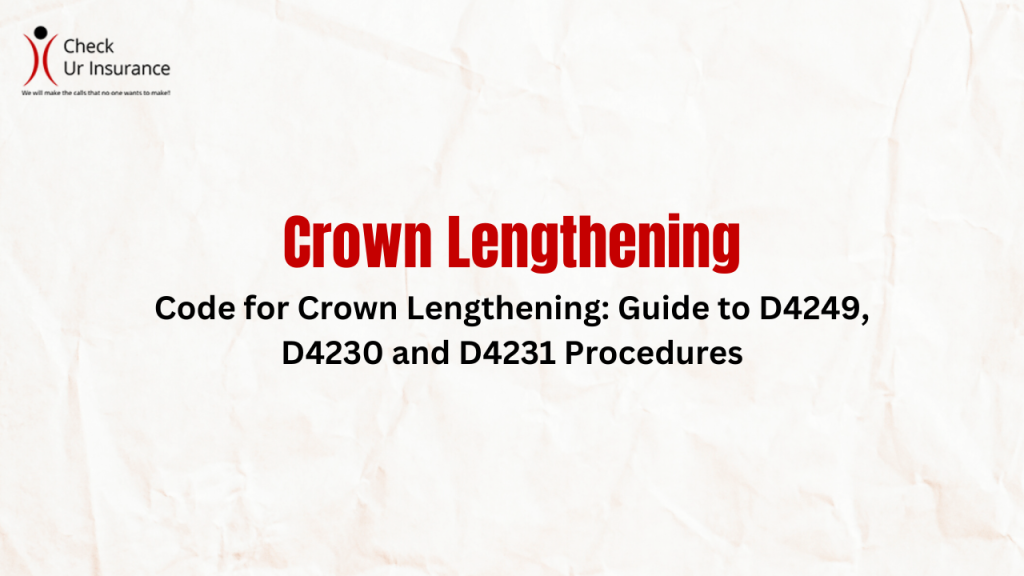Code for Crown Lengthening: Guide to D4249, D4230 and D4231 Procedures
Crown lengthening, a key dental procedure, addresses clinical and anatomical challenges affecting esthetics and support for various dental treatments. This guide focuses on three essential Code for crown Lengthening, D4249, D4230 and D4231, providing a concise overview of their significance in reshaping gum and bone tissues.
Table of Contents
Understanding Crown Lengthening
Crown lengthening involves reshaping excess gum and bone tissue to expose more of the natural tooth. This procedure is recommended when the clinical or anatomical shortness of the crown compromises esthetics or support for dental interventions.
D4249: Clinical Crown Lengthening—Hard Tissue
D4249 is a specific code for crown Lengthening listed in the CDT 2009-10, denoting clinical crown lengthening where the hard tissue (bone) is reshaped to expose the crown of the tooth. This procedure is crucial for enhancing the visibility and support of the tooth’s natural crown.
D4230: Anatomical Crown Exposure – Four or More Contiguous Teeth
For a broader impact, D4230 comes into play. This code encompasses the exposure of four or more contiguous teeth per quadrant by reshaping both soft and hard tissue. It is a comprehensive approach to achieving a harmonious gum line and a natural, wide smile.
D4231: Anatomical Crown Exposure – One to Three Teeth
D4231 addresses cases where exposure is required for one to three teeth per quadrant. Similar to D4230, this procedure involves reshaping both soft and hard tissue. It offers a targeted solution to enhance the visibility and balance of specific teeth.
Code For Crown Lengthening in Action
To illustrate the application of these codes, imagine a scenario where a patient seeks esthetic improvement and support for dental work. The dentist may opt for D4249 to enhance a single tooth or choose D4230 or D4231 for a more comprehensive approach, ensuring a balanced gum line and a pleasing smile.
FAQs
Can Crown Lengthening Be Done for Esthetic Purposes Only?
Absolutely. D4249, D4230, and D4231 can all be employed for esthetic enhancements, ensuring a confident and pleasing smile.
Is Crown Lengthening Painful?
Discomfort is minimal, thanks to local anesthesia used during the procedure. Patients typically experience a smooth and relatively pain-free process.
How Long Does the Crown Lengthening Procedure Take?
The duration varies based on the chosen code and the complexity of the case. However, most procedures are completed within one to two hours.
Will Insurance Cover Crown Lengthening?
Coverage depends on the specific insurance plan. It’s advisable to check with the provider beforehand to understand the extent of coverage.
Are There Risks Associated with Crown Lengthening?
Like any dental procedure, there are minimal risks. However, with proper care and professional execution, complications are rare.
When Can I Expect to See Results?
Visible improvements are often noticeable within a few weeks, with the full outcome becoming apparent as the healing process completes over a few months.
Conclusion
The crown lengthening code, particularly D4249, D4230, and D4231, stands as a transformative solution for enhancing esthetics and support in dental procedures. Whether for a single tooth or a broader smile, these codes offer precision and confidence in achieving the desired results.
Boost your clinic’s efficiency with Check Ur Insurance! Outsource the hassle of insurance data collection to us and free up your resources. Join satisfied clinics in Southern California – call 951-479-1967 or email info@checkurinsurance.com to see how we can tailor our services for your office.
Did you like this article? Read more helpful latest blogs

